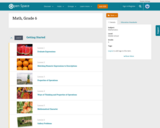
277 Results


Surface Area and Volume
Type of Unit: Conceptual
Prior Knowledge
Students should be able to:
Identify rectangles, parallelograms, trapezoids, and triangles and their bases and heights.
Identify cubes, rectangular prisms, and pyramids and their faces, edges, and vertices.
Understand that area of a 2-D figure is a measure of the figure's surface and that it is measured in square units.
Understand volume of a 3-D figure is a measure of the space the figure occupies and is measured in cubic units.
Lesson Flow
The unit begins with an exploratory lesson about the volumes of containers. Then in Lessons 2–5, students investigate areas of 2-D figures. To find the area of a parallelogram, students consider how it can be rearranged to form a rectangle. To find the area of a trapezoid, students think about how two copies of the trapezoid can be put together to form a parallelogram. To find the area of a triangle, students consider how two copies of the triangle can be put together to form a parallelogram. By sketching and analyzing several parallelograms, trapezoids, and triangles, students develop area formulas for these figures. Students then find areas of composite figures by decomposing them into familiar figures. In the last lesson on area, students estimate the area of an irregular figure by overlaying it with a grid. In Lesson 6, the focus shifts to 3-D figures. Students build rectangular prisms from unit cubes and develop a formula for finding the volume of any rectangular prism. In Lesson 7, students analyze and create nets for prisms. In Lesson 8, students compare a cube to a square pyramid with the same base and height as the cube. They consider the number of faces, edges, and vertices, as well as the surface area and volume. In Lesson 9, students use their knowledge of volume, area, and linear measurements to solve a packing problem.
- Subject:
- Geometry
- Mathematics
- Provider:
- Pearson
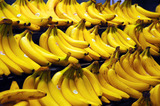
Lesson OverviewStudents revise their packing plans based on teacher feedback and then take a quiz.Students will use their knowledge of volume, area, and linear measurements to solve problems. They will draw diagrams to help them solve a problem and track and review their choice of problem-solving strategies.Key ConceptsConcepts from previous lessons are integrated into this assessment task: finding the volume of rectangular prisms. Students apply their knowledge, review their work, and make revisions based on feedback from the teacher and their peers. This process creates a deeper understanding of the concepts.Goals and Learning ObjectivesApply your knowledge of the volume of rectangular prisms.Track and review your choice of strategy when problem-solving.
- Subject:
- Geometry
- Material Type:
- Lesson Plan
- Author:
- Chris Adcock
- Date Added:
- 02/28/2022
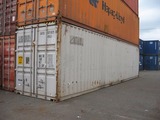
Lesson OverviewStudents explore nets—2-D patterns that can be folded to form 3-D figures. They start by examining several patterns and determining which nets form a cube. Then, they sketch nets for rectangular prisms. They also find the surface area of the rectangular prisms.ELL: Remind students of the units used to measure area and volume. Use this opportunity to reinforce why square units are used for area (2-D) and cubed units are used for volume (3-D).MathematicsA net is a 2-D pattern that can be folded to form a 3-D figure. In this lesson, the focus is on nets for rectangular prisms. There are many possible nets for any given prism. For example, there are 11 different nets for a cube, as shown below.The surface area of a prism is the area of its net.Goals and Learning ObjectivesIdentify nets for cubes.Sketch the net of a rectangular prism.Find the surface area of a rectangular prism.
- Subject:
- Geometry
- Material Type:
- Lesson Plan
- Author:
- Chris Adcock
- Date Added:
- 02/28/2022
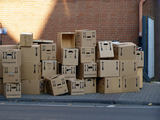
Lesson OverviewStudents build prisms with fractional side lengths by using unit-fraction cubes (i.e., cubes with side lengths that are unit fractions, such as 13 unit or 14 unit). Students verify that the volume formula for rectangular prisms, V = lwh or V = bh, applies to prisms with side lengths that are not whole numbers.Key ConceptsIn fifth grade, students found volumes of prisms with whole-number dimensions by finding the number of unit cubes that fit inside the prisms. They found that the total number of unit cubes required is the number of unit cubes in one layer (which is the same as the area of the base) times the number of layers (which is the same as the height). This idea was generalized as V = lwh, where l, w, and h are the length, width, and height of the prism, or as V = Bh, where B is the area of the base of the prism and h is the height.Unit cubes in each layer = 3 × 4Number of layers = 5Total number of unit cubes = 3 × 4 × 5 = 60Volume = 60 cubic unitsIn this lesson, students extend this idea to prisms with fractional side lengths. They build prisms using unit-fraction cubes. The volume is the number of unit-fraction cubes in the prism times the volume of each unit-fraction cube. Students show that this result is the same as the volume found by using the formula.For example, you can build a 45-unit by 35-unit by 25-unit prism using 15-unit cubes. This requires 4 × 3 × 2, or 24, 15-unit cubes. Each 15-unit cube has a volume of 1125 cubic unit, so the total volume is 24125 cubic units. This is the same volume obtained by using the formula V = lwh:V=lwh=45×35×25=24125.15-unit cubes in each layer = 3 × 4Number of layers = 2Total number of 15-unit cubes = 3 × 4 × 2 = 24Volume = 24 × 1125 = 24125 cubic units Goals and Learning ObjectivesVerify that the volume formula for rectangular prisms, V = lwh or V = Bh, applies to prisms with side lengths that are not whole numbers.
- Subject:
- Geometry
- Material Type:
- Lesson Plan
- Author:
- Chris Adcock
- Date Added:
- 02/28/2022
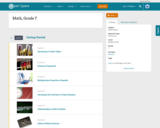
- Subject:
- Mathematics
- Material Type:
- Full Course
- Provider:
- Pearson
- Date Added:
- 02/28/2022

Putting Math to Work
Type of Unit: Problem Solving
Prior Knowledge
Students should be able to:
Solve problems involving all four operations with rational numbers.
Write ratios and rates.
Write and solve proportions.
Solve problems involving scale.
Write and solve equations to represent problem situations.
Create and interpret maps, graphs, and diagrams.
Use multiple representations (i.e., tables, graphs, and equations) to represent problem situations.
Calculate area and volume.
Solve problems involving linear measurement.
Lesson Flow
Students apply and integrate math concepts they have previously learned to solve mathematical and real-world problems using a variety of strategies. Students have opportunities to explore four real-world situations involving problem solving in a variety of contexts, complete a project of their choice, and work through a series of Gallery problems.
First, students utilize their spatial reasoning and visualization skills to find the least number of cubes needed to construct a structure when given the front and side views. Then, students select a project to complete as they work through this unit to refine their problem-solving skills. Students explore the relationship between flapping frequency, amplitude, and cruising speed to calculate the Strouhal number of a variety of flying and swimming animals. After that, students explore the volume of the Great Lakes, applying strategies for solving volume problems and analyzing diagrams. Next, students graphically represent a virtual journey through the locks of the Welland Canal, estimating the amount of drop through each lock and the distance traveled. Students have a day in class to work on their projects with their group.
Then, students have two days to explore Gallery problems of their choosing. Finally, students present their projects to the class.
- Subject:
- Mathematics
- Provider:
- Pearson

Allow students who have a clear understanding of the content thus far in the unit to work on Gallery problems of their choosing. You can then use this time to provide additional help to students who need review of the unit's concepts or to assist students who may have fallen behind on work.Gallery ProblemsThe SS Edmund FitzgeraldStudents solve mathematical problems about the sinking of the ship Edmund Fitzgerald.SpiralsStudents learn about the mathematics of spirals. They see spirals in nature and connect spirals to the Fibonacci.Ship It!Students learn about shipping containers and use a unit of measure that is only used in the shipping industry the twenty-foot equivalent unit (TEU).Rideau Canal WaterwayStudents compare information about the Rideau Canal and compare it with the Welland Canal.A Rule of ThumbStudents learn about a “rule of thumb” that people use to estimate the speed of a train they are riding on. They investigate the mathematics of this rule.IntersectionStudents use information on a map to calculate where two streets will intersect.Tolstoy's ProblemStudents learn about Leo Tolstoy, a Russian writer who wrote two of the greatest novels of all time. They solve a problem that Tolstoy found very interesting.The Dog RunStudents imagine having 22 meters of wire fencing for a dog run. They investigate how the area of the dog run changes as the length varies.Bodies of WaterStudents investigate a claim on the Runner's World website about the amount of water in the body of a 160-pound man.
- Subject:
- Geometry
- Material Type:
- Lesson Plan
- Author:
- Chris Adcock
- Date Added:
- 03/01/2022
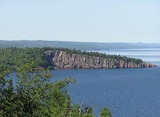
How much water is in the Great Lakes? Students read and interpret a diagram that shows physical features of the Great Lakes and answer questions based on the diagram. They find the volume of each of the Great Lakes, as well as all five lakes combined, and make a bar graph to represent the volumes.Key ConceptsStudents are expected to use the mathematical skills they have acquired in previous lessons or in previous math courses. The lessons in this unit focus on developing and refining problem-solving skills.Students will:Try a variety of strategies to approaching different types of problems.Devise a problem-solving plan and implement their plan systematically.Become aware that problems can be solved in more than one way.See the value of approaching problems in a systematic manner.Communicate their approaches with precision and articulate why their strategies and solutions are reasonable.Make connections between previous learning and real-world problems.Create efficacy and confidence in solving challenging problems in a real-world setting.Goals and Learning ObjectivesRead and interpret graphs and diagrams.Solve problems involving volume.
- Subject:
- Geometry
- Material Type:
- Lesson Plan
- Author:
- Chris Adcock
- Date Added:
- 03/01/2022

Zooming In On Figures
Unit Overview
Type of Unit: Concept; Project
Length of Unit: 18 days and 5 days for project
Prior Knowledge
Students should be able to:
Find the area of triangles and special quadrilaterals.
Use nets composed of triangles and rectangles in order to find the surface area of solids.
Find the volume of right rectangular prisms.
Solve proportions.
Lesson Flow
After an initial exploratory lesson that gets students thinking in general about geometry and its application in real-world contexts, the unit is divided into two concept development sections: the first focuses on two-dimensional (2-D) figures and measures, and the second looks at three-dimensional (3-D) figures and measures.
The first set of conceptual lessons looks at 2-D figures and area and length calculations. Students explore finding the area of polygons by deconstructing them into known figures. This exploration will lead to looking at regular polygons and deriving a general formula. The general formula for polygons leads to the formula for the area of a circle. Students will also investigate the ratio of circumference to diameter ( pi ). All of this will be applied toward looking at scale and the way that length and area are affected. All the lessons noted above will feature examples of real-world contexts.
The second set of conceptual development lessons focuses on 3-D figures and surface area and volume calculations. Students will revisit nets to arrive at a general formula for finding the surface area of any right prism. Students will extend their knowledge of area of polygons to surface area calculations as well as a general formula for the volume of any right prism. Students will explore the 3-D surface that results from a plane slicing through a rectangular prism or pyramid. Students will also explore 3-D figures composed of cubes, finding the surface area and volume by looking at 3-D views.
The unit ends with a unit examination and project presentations.
- Subject:
- Geometry
- Mathematics
- Provider:
- Pearson

Students discover the formula for finding the volume of a pyramid and apply the formula to solve problems.Key ConceptsThe volume of a pyramid is one-third the volume of a prism with the same base and height. The shape of the base does not matter (including if it’s a circle), and students will see the same one-third comparison between a cylinder and cone.GoalsUnderstand the formula for the volume of a pyramid.Apply the volume formula to solve problems.
- Subject:
- Geometry
- Material Type:
- Lesson Plan
- Author:
- Chris Adcock
- Date Added:
- 03/01/2022

Students will extend their knowledge of volume to find the volume of right prisms, seeing that the volume is the area of the base multiplied by the height.Key ConceptsVolume is measured in cubic units. The area of the base of a prism indicates how many cubic units are in the first unit “layer” of the prism. Multiplying by height gives the number of layers, and therefore the volume.GoalsFind the volume of right prisms.SWD: Some students with disabilities may have difficulty connecting newly introduced information with previously learned concepts. Consider ways to help students with disabilities to make connections between what they have learned in previous lessons about volume and right prisms and finding the volume of right prisms.Consider the prerequisite skills for this lesson. Students with disabilities may need direct instruction and guided practice with the skills, measurement, and concepts needed for this lesson.Students should understand these domain-specific terms:volumeright (domain-specific)prismcubicIt may be helpful to preteach these terms to students with disabilities.ELL: As new vocabulary is introduced, be sure to repeat it several times and allow students to repeat after you as needed. Write the new words as they are introduced, and allow enough time for ELLs to check their dictionaries or briefly consult with another student who shares the same primary language if they wish.
- Subject:
- Geometry
- Material Type:
- Lesson Plan
- Author:
- Chris Adcock
- Date Added:
- 03/01/2022
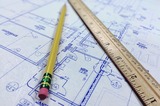
Students are introduced to real-world applications of geometry and measurement by looking at architectural plans. Students also begin to get familiar with reading architectural plans and thinking about scale.Key ConceptsSince this lesson is exploratory, all of the mathematics discussed will be informal. However, most of the mathematics that students will see in the unit is introduced in this lesson. Students look at length, area, surface area, and volume and examine how these measurements pertain to architectural plans and determining building costs. Students will also consider scale and how scale is used in architectural plans and math drawings.GoalsThink about what measurements are needed to build a building.Think about what measurements determine the cost of a building.Think about how scale is used in math drawings.SWD: Check in to ensure that students understand the meaning of domain-specific vocabulary terms such as dimensions, scale, and area. You may also need to clarify the meaning of the word contract for some students.ELL: Consider having students compile a list or resource with key vocabulary terms for this unit.
- Subject:
- Geometry
- Material Type:
- Lesson Plan
- Author:
- Chris Adcock
- Date Added:
- 03/01/2022
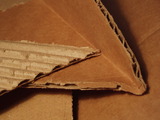
Lesson OverviewStudents will work on the final portion of their project which includes creating the nets for the sides, making a slice in one of their buildings, and putting their buildings together. Once their two model buildings are complete, they will find the surface area and volume for their models and the full-size buildings their models represent.Key ConceptsThe second part of the project is essentially a review of the second half of the unit, while still using scale drawings. Students will find the surface area of a prism as well as the surface area of a truncated prism. The second prism will require estimating and problem solving to figure out the net and find the surface area. Students will also be drawing the figure using scale to find actual surface area.GoalsRedraw a scale drawing at a different scale.Find measurements using a scale drawing.Find the surface area of a prism.SWD: Students with disabilities may have a more challenging time identifying areas of improvement to target in their projects. It may be helpful to model explicitly for students (using an example project or student sample) how to review a project using the rubric to assess and plan for revisions based on that assessment.Students with fine motor difficulties may require grid paper with a larger scale. Whenever motor tasks are required, consider adaptive tools or supplementary materials that may benefit students with disabilities.Students with disabilities may struggle to recall prerequisite skills as they move through the project. It may be necessary to check in with students to review and reinforce estimation skills.
- Subject:
- Geometry
- Material Type:
- Lesson Plan
- Author:
- Chris Adcock
- Date Added:
- 03/01/2022

Investigate the concepts of area, volume, 3D shapes, and nets using this interactive Learn Alberta math. The solid shapes focused on this exploration include rectangular and triangular prisms, rectangular and triangular pyramids, cylinders, and cones. Be sure to follow the link to the printable activities, solutions, learning strategies, and circle pong math game that are included to reinforce target skills. A video accompanies this resource to show real-life applications of the lesson's content.
- Subject:
- Mathematics
- Material Type:
- Interactive
- Provider:
- Learn Alberta
- Date Added:
- 08/07/2023

This multimedia Learn Alberta math resource looks at surface area and volume and how math involved in the design of large inflatable shapes. The accompanying interactive component lets students investigate a variety of cylinders to get a target volume and surface area. Be sure to follow the link to the printable activity included to reinforce target skills. A video accompanies the lesson to show real-life application of the lesson's content.
- Subject:
- Mathematics
- Material Type:
- Interactive
- Provider:
- Learn Alberta
- Date Added:
- 08/07/2023

This site gives brief information on Cavalieri's Principle.
- Subject:
- Mathematics
- Material Type:
- Reading
- Provider:
- Wolfram
- Date Added:
- 12/01/2023

Learn how to find the volume of a rectangular prism. [4:29]
- Subject:
- Mathematics
- Material Type:
- Audio/Video
- Date Added:
- 08/01/2022

In this interactive lesson, learn what the "physical properties" of matter are and how can they be measured and observed.
- Subject:
- Science
- Material Type:
- Interactive
- Lesson
- Provider:
- PBS LearningMedia
- Date Added:
- 11/06/2023

Students learn the metric units engineers use to measure mass, distance (or length) and volume. They make estimations using these units and compare their guesses with actual values. To introduce the concepts, the teacher needs access to a meter stick, a one-liter bottle, a glass container that measures milliliters and a gram scale.
- Subject:
- Engineering
- Mathematics
- Measurement and Data
- Science
- Material Type:
- Lesson Plan
- Provider:
- TeachEngineering
- Provider Set:
- TeachEngineering
- Author:
- Janet Yowell
- Lesley Herrmann
- Malinda Schaefer Zarske
- Date Added:
- 09/18/2014